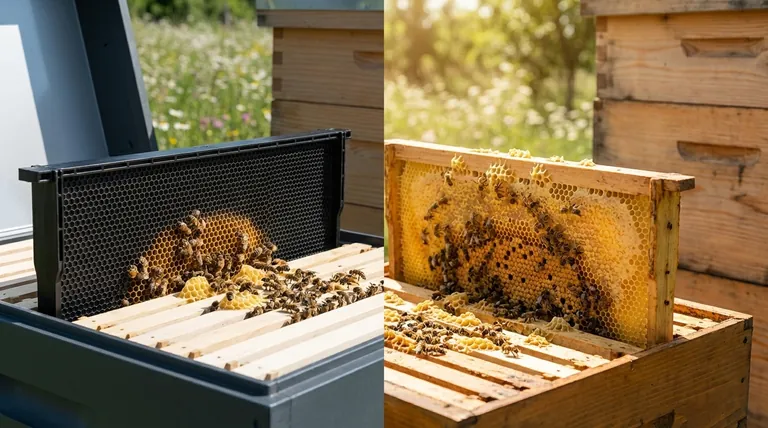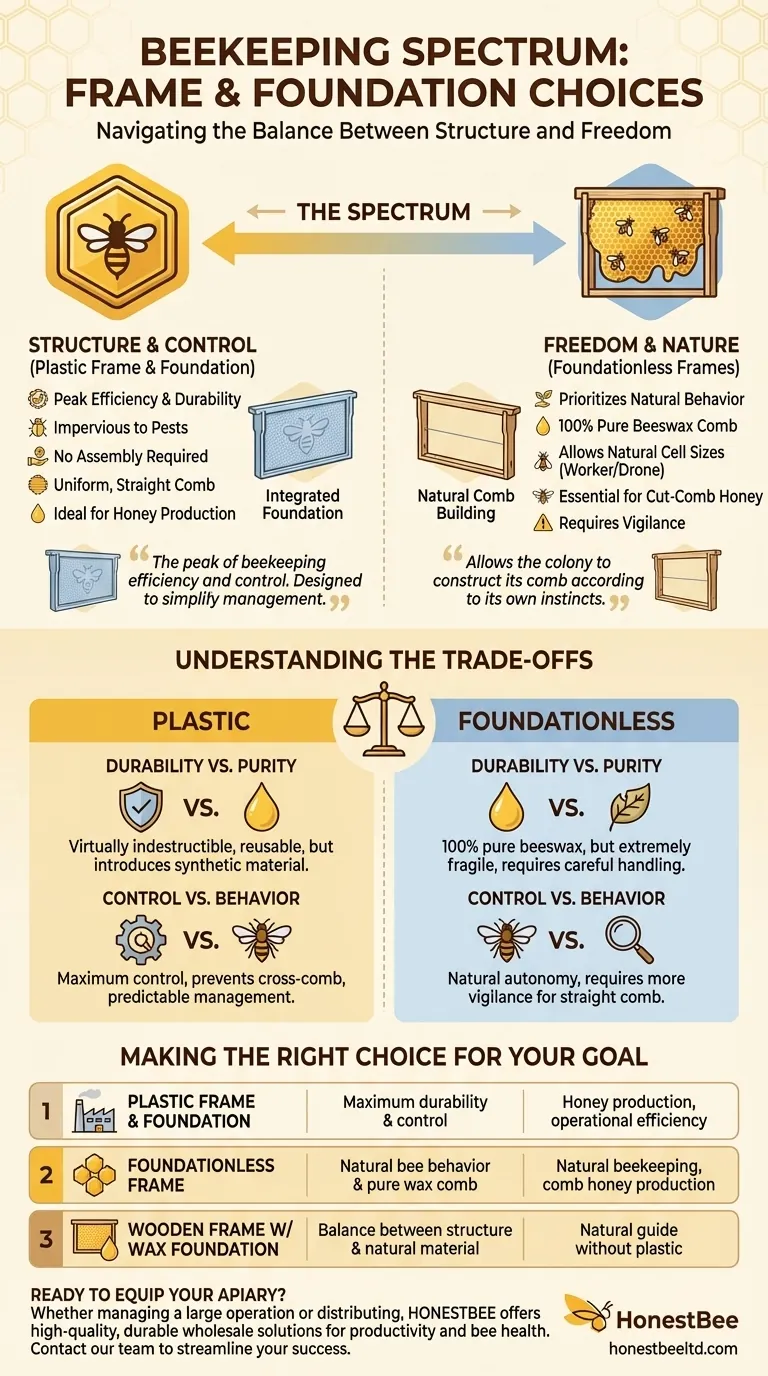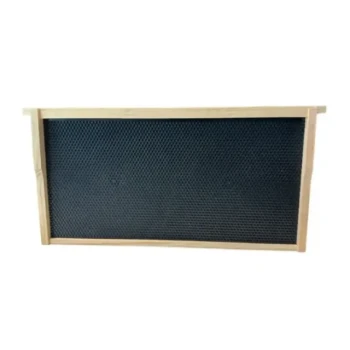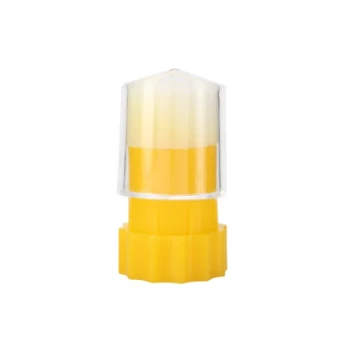In beekeeping, the two ends of the spectrum for hive structure are plastic frames with integrated plastic foundation and completely foundationless frames. The former offers beekeepers maximum control and durability by providing a pre-formed base, while the latter gives bees complete freedom to build their comb naturally, without any guide.
The choice between a fully plastic system and a foundationless one is a fundamental decision for any beekeeper, trading the convenience and durability of manufactured equipment against the natural purity and behavioral freedom of bee-built comb.

The Case for Structure: Plastic Frame & Foundation
A fully plastic frame and foundation system represents the peak of beekeeping efficiency and control. It is designed to simplify management and maximize durability.
What It Is
This is typically a single, molded piece of food-grade plastic that serves as both the frame and the foundation. The foundation surface is embossed with the hexagonal pattern of worker-sized cells and is often coated with a thin layer of beeswax to encourage the bees to accept it and begin building.
Advantages for the Beekeeper
The primary benefits are durability and convenience. Plastic frames are impervious to wax moths and rodents, will not break during honey extraction even at high speeds, and can be scraped clean and reused for years. They require no assembly, saving significant time.
Impact on the Bees
Bees are given a rigid and perfectly uniform guide. This encourages them to build comb quickly and ensures every frame is straight and interchangeable, which drastically simplifies hive inspections.
The Case for Freedom: Foundationless Frames
Foundationless beekeeping is an approach that prioritizes natural bee behavior over beekeeper convenience. It allows the colony to construct its comb according to its own instincts.
What It Is
A foundationless frame is simply an empty frame, usually made of wood. It provides the outer structure but leaves the interior empty for the bees to fill entirely with their own wax. Often, a small wooden guide or a line of melted wax is added to the underside of the top bar to encourage the bees to build straight down.
Advantages for the Beekeeper
This method is the only way to produce pure cut-comb honey, as the entire comb is new and edible. For beekeepers aligned with a "natural" or "treatment-free" philosophy, it ensures there is nothing but the bees' own wax in the hive.
Impact on the Bees
Bees build comb with cell sizes of their own choosing, including larger drone cells, which is a vital part of the colony's natural reproductive and social cycle. This method gives the colony complete autonomy over the internal architecture of its nest.
Understanding the Trade-offs
Choosing between these two systems involves a clear set of compromises. Your decision will depend entirely on your goals as a beekeeper.
The Durability vs. Purity Dilemma
Plastic is virtually indestructible but introduces a synthetic material into the hive. While it can be reused indefinitely, it is still plastic.
Foundationless comb is 100% pure beeswax but is extremely fragile. It can easily break during inspections, especially in hot weather, and requires much slower, more careful handling during honey extraction.
The Control vs. Behavior Dilemma
Plastic offers maximum control. It prevents "cross comb" (where bees build comb across multiple frames), making hive management predictable and straightforward.
Foundationless requires more vigilance. The beekeeper must monitor the hive closely, especially in the beginning, to ensure the bees are building straight comb. However, it allows the colony to manage its own ratio of worker-to-drone cells, a key element of natural hive behavior.
Making the Right Choice for Your Goal
Your choice of foundation is a direct reflection of your beekeeping philosophy and what you hope to achieve.
- If your primary focus is honey production and operational efficiency: Plastic frames offer unmatched durability, speed, and ease of management, making them the superior choice for a production-oriented apiary.
- If your primary focus is natural beekeeping or harvesting comb honey: Foundationless frames are essential, as they allow bees to build pure, new wax without any synthetic guides.
- If you are seeking a balance between structure and natural material: Consider using wooden frames with pure beeswax foundation sheets, which provides a natural guide without introducing plastic.
Ultimately, understanding this spectrum empowers you to select the equipment that best aligns with your purpose and principles as a beekeeper.
Summary Table:
| Choice | Key Feature | Best For |
|---|---|---|
| Plastic Frame & Foundation | Maximum durability and control | Honey production, operational efficiency |
| Foundationless Frame | Natural bee behavior and pure wax comb | Natural beekeeping, comb honey production |
Ready to equip your apiary with the right frames? Whether you manage a large commercial operation or are a distributor seeking durable, efficient equipment, HONESTBEE has the wholesale solutions for you. We supply high-quality beekeeping supplies designed for productivity and bee health. Contact our team today to discuss your needs and streamline your beekeeping success.
Visual Guide

Related Products
- Plastic Bee Frame Beekeeping Hive Frames for Wholesale
- Assembled Wooden Bee Frames with Plastic Foundation for Durability and Convenience by HONESTBEE
- Heavy-Duty Stainless Steel Clip-On Frame Perch
- 7 x Auto Bee Flow Hive Frames Plastic Beekeeping Hive Box Supplies
- Professional In-Hive Bee Feeder HONESTBEE Frame for Beekeeping
People Also Ask
- Can you boil plastic bee frames? Avoid This Costly Mistake and Protect Your Hive
- What is a general rule for beekeepers with many hives regarding frame choice? Maximize Efficiency with Plastic Frames
- What are the differences between wooden and plastic frames in beehives? Choose the Best for Your Apiary
- Can beekeepers switch between wooden and plastic frames? Optimize Your Hive's Performance
- Are plastic frames good? Boost Apiary Efficiency with Durable, Pest-Resistant Frames



















